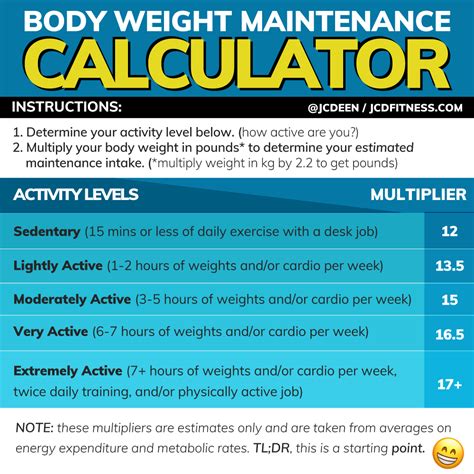How to Calculate Your Maintenance Calories: A Simple Guide
Knowing your maintenance calorie level is crucial for achieving your fitness goals, whether you're aiming to lose weight, gain muscle, or simply maintain your current physique. It's the number of calories your body needs to maintain its current weight and function optimally. This guide provides a straightforward method for calculating your maintenance calories and understanding how to adjust them based on your activity level.
Understanding Basal Metabolic Rate (BMR)
Before calculating your maintenance calories, you need to understand your Basal Metabolic Rate (BMR). This is the number of calories your body burns at rest, simply to keep your organs functioning, breathing, and circulating blood. Several methods exist to estimate your BMR, but one of the most common is using online calculators or formulas. These often require your:
- Age: Metabolic rate naturally slows down with age.
- Gender: Men generally have a higher BMR than women due to differences in muscle mass and body composition.
- Height: Taller individuals tend to have a higher BMR.
- Weight: Heavier individuals generally have a higher BMR.
Many free online calculators are readily available; simply search "BMR calculator" on your preferred search engine. Remember that these are estimations, and individual results may vary.
Why BMR Isn't Enough
While your BMR is a vital component, it doesn't tell the whole story. Your daily calorie expenditure includes more than just resting metabolism. You also need to account for your activity level.
Calculating Your Total Daily Energy Expenditure (TDEE)
Your Total Daily Energy Expenditure (TDEE) is a more comprehensive calculation that considers your BMR and your activity level. It's the total number of calories you burn in a day. To calculate your TDEE, you'll multiply your BMR by an activity multiplier:
- Sedentary (little to no exercise): Multiply your BMR by 1.2
- Lightly Active (light exercise/sports 1-3 days/week): Multiply your BMR by 1.375
- Moderately Active (moderate exercise/sports 3-5 days/week): Multiply your BMR by 1.55
- Very Active (hard exercise/sports 6-7 days a week): Multiply your BMR by 1.725
- Extra Active (very hard exercise/sports & physical job or 2x training): Multiply your BMR by 1.9
Example: Let's say your BMR is 1500 calories, and you're moderately active. Your TDEE would be 1500 x 1.55 = 2325 calories. This is your estimated maintenance calorie level.
Fine-Tuning Your Maintenance Calories
The numbers generated are just estimations. The best way to truly determine your maintenance calories is through experimentation. Track your calorie intake and weight for a few weeks. If your weight remains stable, you've found a good approximation of your maintenance calories. If you gain weight, you may need to slightly reduce your calorie intake. If you lose weight, a slight increase may be necessary.
Factors Affecting Calorie Needs:
- Muscle Mass: More muscle mass increases your BMR.
- Genetics: Individual metabolic rates vary genetically.
- Stress Levels: High stress can affect metabolism.
- Sleep: Lack of sleep can disrupt hormonal balance and metabolism.
Using Your Maintenance Calories Effectively
Once you have a reasonable estimate of your maintenance calories, you can use this information to plan your diet effectively. To lose weight, create a moderate calorie deficit (around 250-500 calories per day). To gain weight, create a slight calorie surplus. Always prioritize whole, unprocessed foods and a balanced diet regardless of your goals. Remember to consult a healthcare professional or registered dietitian for personalized advice, especially if you have any underlying health conditions.
